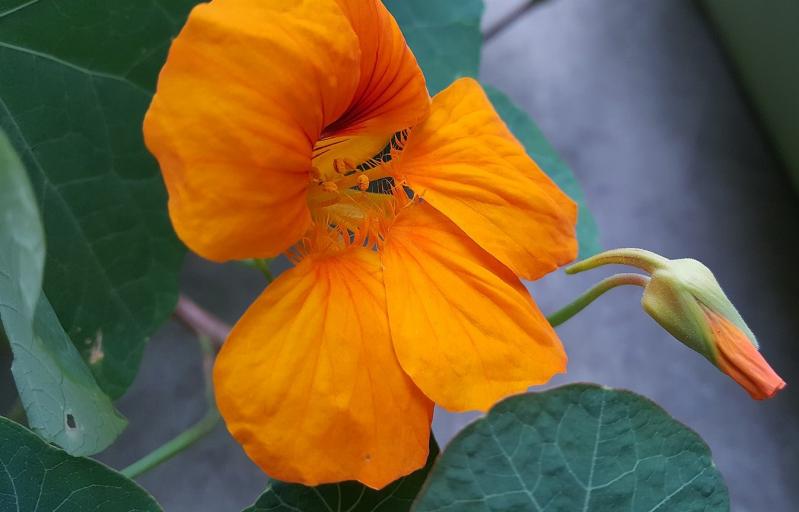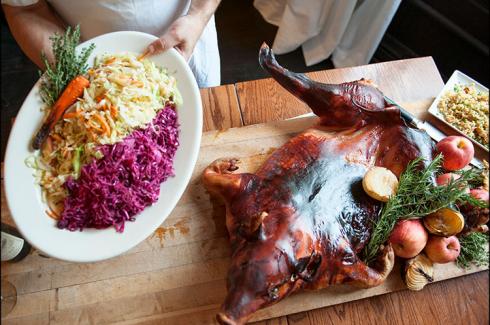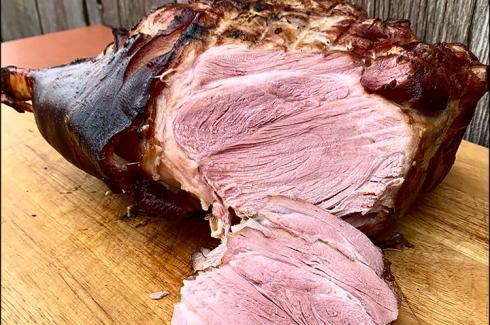Flowers, with their sweet fragrances and riotous color, are balm for the senses and for the eye. Of late, nouvelle-trendy watering spots have introduced them as stylish garnish and amusing nibbles. Less known is the fact that flowers were a common and popular ingredient in recipes in the 17th, 18th, and 19th centuries.
Most gardeners have probably tasted a nasturtium flower at one time or another. This abundant yellow and carmine annual blooms most of the summer, and its flowers have a distinctively spicy, almost peppery, taste, delicious when added judiciously to a salad. T heir seed pods have been used pickled as a substitute for capers, and their large round leaves are a favorite with caterers when decorating food.
Nasturtium s are not by any means the sole edible flower. T hose who are fond of Indian food know that rose petals are often used to flavor desserts and the refreshing yogurt “milkshake” known as lassi, which complements so beautifully the hot, spicy food of that country.
Flowering Of Romance
Most will also be familiar with candied violets, long used for decorations or simply as a treat for the sweet tooth. These are easily made in spring, when the tiny purple flowers are everywhere, by coating them in beaten egg white, covering them with finely ground castor sugar, and allowing them to dry.
Candied violets and the lesser-known candied mimosa blossoms, which are tiny yellow dots, make lovely additions to a wedding cake. Strung together on a white cake with green frosting “vines,” either one or both are a fairly foolproof way to create a spectacularly romantic confection. A coeur a la creme flavored with violet water and garnished with the candied flowers is a delight to the palate as well as the heart.
If the herbs in your garden are running rampant, try using their flowers — chives, basil, thyme, dill, oregano, or sage — to flavor meats and poultry, and to create herb vinegars. White wine or plain distilled vinegar will take its color from the flowers, and make jewel-like gifts that cost little more than time and a pretty jar.
Sweets Of The Garden
If you have ever tasted a cake scented with lemon verbena or rose geranium, you know that the perfume of flowers translates well when used in sweets. Honeysuckle, delicious in the field — children often pull the end out of the blossom to taste the drop of nectar there — can be used in baked goods, too.
Hibiscus blossoms make a popular ruby-red herb tea that is a caffeine-free substitute for black tea, and especially refreshing when served iced with a sprig of mint.
The Italians may have discovered the charm of eating zucchini and other squash blossom fried or stuffed with meats or vegetables, but now we can all enjoy them that way, as well as displayed on the plate by those who believe the visual presentation of food is part of the magic. T hey can also be cooked up in soup to thicken the liquid. And remember, overburdened zucchini gardeners, eating the flowers will diminish the eventual number of squashes you have to eat or give away.
Even More Than A Treat
Of course, even less-than-tasty flowers are useful for decorating platters. Sometimes simply placing a few colorful blossoms on the edges of a serving platter can elevate the ordinary to the sublime.
The flavor of honey is determined by which flowers the bees feed on, but you can also flavor honey by tucking in flowers from your own garden, such as violets or rose petals. After the honey has set with the flowers for 10 days, its natural preservatives will have preserved the blossoms.
The golden-hued calendula was believed by the 17th-century herbalist Nicholas Culpepper to be a “comforter of the heart and spirits.” If you make your own cheese, try adding calendula to the mix.
Flowers are not only a treat for the eye and, sometimes, the palate, they are also rich in nectar and pollen. Many herbalists and health food enthusiasts look upon pollen as a nutritious food filled with vitamins, minerals, and essential oils. Flower extracts have been used to treat allergies and digestive and intestinal disorders. Maybe nibbling at buds and blossoms will even improve your health.
A Fragrant Cake
Cake:
3 Tbsp. finely chopped lemon verbena
1 cup milk
1 cup unsalted butter
2 cups sugar
4 eggs, separated
1 tsp. vanilla extract
3 cups flour
2 tsp. baking powder
6 to 8 lime geranium leaves
Frosting:
1/4 cup milk
2 Tbsp. chopped lemon verbena
1/2 cup unsalted butter
16 ounces lime geranium confectioners’ sugar *
Juice of one lemon
Preheat oven to 350 degrees. In a heavy saucepan, add the lemon verbena to the milk and heat to the scalding point. Remove from the heat and cool. Strain. l.i a mixing bowl, cream the butter. Add the sugar gradually and beat until light and fluffy. Add the egg yolks one at a time and stir in the vanilla extract. In another bowl, combine flour and baking powder and then add the other two mixtures.
Beat the eggs till stiff but not dry and fold one-third of the whites into the batter to lighten it, then fold in the rest.
Put three to four washed leaves of lime geranium in the bottom of two buttered and w ax-paper-lined nine-inch cake pans. Place batter in the pans and bake for 25 minutes, or until a toothpick comes out of the center cleanly.
When cooled, turn out on a rack and remove wax paper and geranium leaves.
To make the frosting, heat the milk with the lemon verbena and let stand a half-hour. Strain. Cream the butter and gradually add flavored sugar, milk, and juice and beat well until fluffy and light. More milk can be added if necessary.
Spread the frosting between and around the layers and decorate with sprigs of lime geranium or lemon verbena.
*To make sugar, empty a 16-ounce box of confectioners' sugar in a plastic bag with eight lightly-crushed lime geranium leaves, and let stand for 24 hours.





